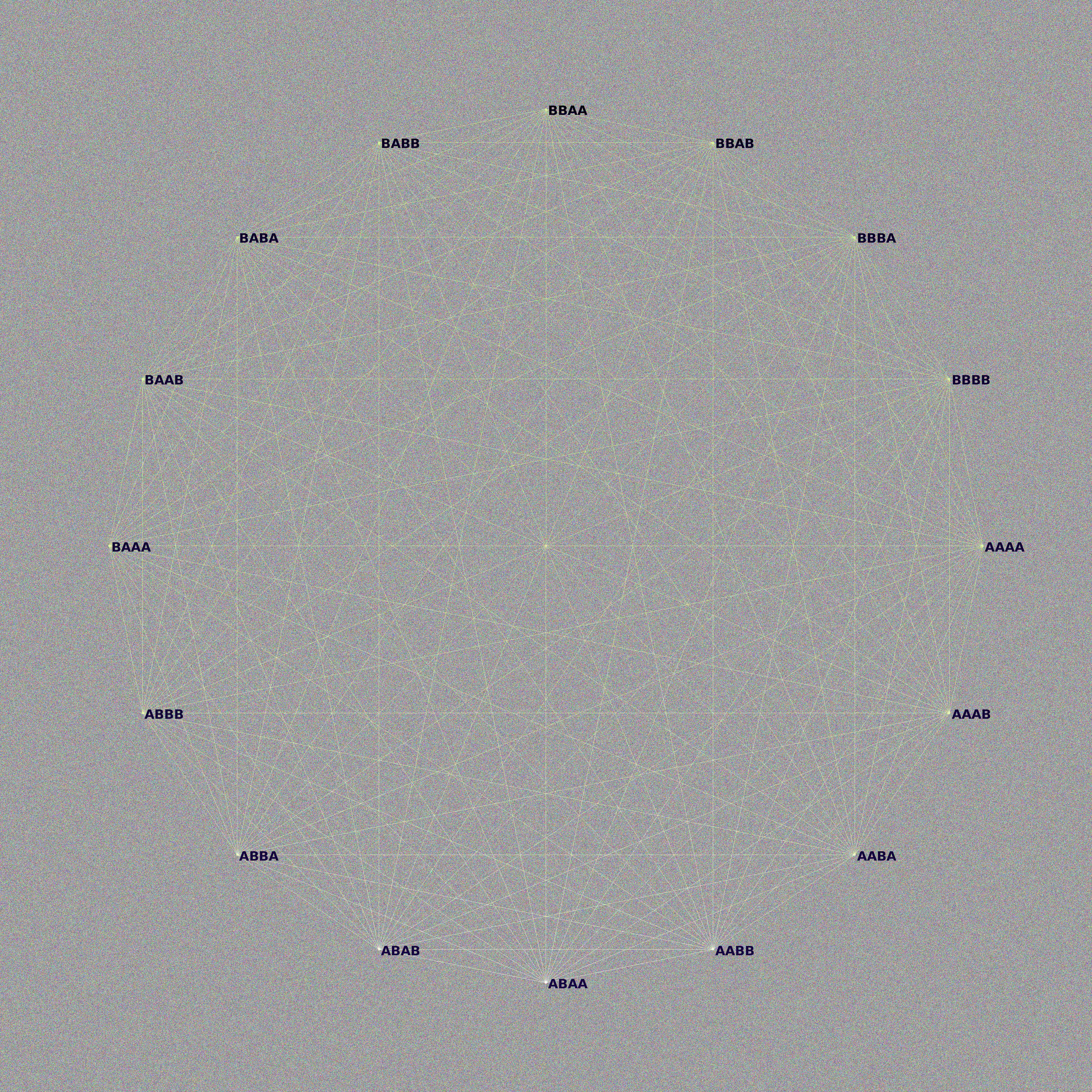


This image was inspired by the concept of the ruliad from The Wolfram Physics Project. Created with Chatgpt and Google Colab.
import numpy as np from PIL import Image, ImageDraw, ImageFont import networkx as nx from itertools import product import random # --- Enhanced: Generate a 4096×4096 image using every 24-bit RGB color once, # with bold labels, a shuffled gray-looking background, and 75% transparent bg. # --- 1. Build the graph ---------------------------------------- alphabet = ['A', 'B'] two_letter = [''.join(p) for p in product(alphabet, repeat=2)] four_letter = [''.join(p) for p in product(alphabet, repeat=4)] G = nx.DiGraph() G.add_nodes_from(four_letter) for state in four_letter: for i in range(3): for tgt in two_letter: new_state = state[:i] + tgt + state[i+2:] G.add_edge(state, new_state) from networkx.algorithms.dag import transitive_closure TC = transitive_closure(G) # --- 2. Layout ------------------------------------------------- W = H = 4096 pos = nx.circular_layout(TC, scale=min(W, H) * 0.4, center=(W/2, H/2)) # --- 3. Render shapes & text to masks ------------------------- mask_shape = Image.new('1', (W, H), 0) draw_shape = ImageDraw.Draw(mask_shape) mask_label = Image.new('1', (W, H), 0) draw_label = ImageDraw.Draw(mask_label) # edges for u, v in TC.edges(): x1, y1 = pos[u] x2, y2 = pos[v] draw_shape.line([(x1, y1), (x2, y2)], fill=1) # nodes r = 3 for _, (x, y) in pos.items(): draw_shape.ellipse([x-r, y-r, x+r, y+r], fill=1) # labels with DejaVuSansBold size 48 try: font = ImageFont.truetype("DejaVuSans-Bold.ttf", size=48) except IOError: font = ImageFont.load_default() for node, (x, y) in pos.items(): txt = node tx, ty = x + r + 5, y - 24 draw_label.text((tx, ty), txt, font=font, fill=1) shape_mask = np.array(mask_shape, dtype=bool) label_mask = np.array(mask_label, dtype=bool) shape_only = shape_mask & ~label_mask bg_mask = ~(shape_mask | label_mask) N = W * H shape_idx = np.flatnonzero(shape_only.ravel()) label_idx = np.flatnonzero(label_mask.ravel()) bg_idx = np.flatnonzero(bg_mask.ravel()) assert len(shape_idx) + len(label_idx) + len(bg_idx) == N # --- 4. Prepare color pools -------------------------- all_colors = np.arange(N, dtype=np.uint32) r_ch = (all_colors >> 16) & 0xFF g_ch = (all_colors >> 8) & 0xFF b_ch = all_colors & 0xFF lum = 0.2126*r_ch + 0.7152*g_ch + 0.0722*b_ch sorted_idx = np.argsort(lum) n_shape = len(shape_idx) n_label = len(label_idx) # brightest for shapes bright_pool = sorted_idx[-n_shape:] # darkest for labels + background dark_pool = sorted_idx[: n_label + (N - n_shape - n_label)] label_colors = dark_pool[:n_label] bg_colors = dark_pool[n_label:] # shuffle background pool for uniform gray appearance random.shuffle(bg_colors) # --- 5. Assemble RGBA image ---------------------------- img_arr = np.zeros((H*W, 4), dtype=np.uint8) def unpack(c): return ((c >> 16) & 0xFF, (c >> 8) & 0xFF, c & 0xFF) # labels: darkest, fully opaque for i, pix in enumerate(label_idx): r_, g_, b_ = unpack(label_colors[i]) img_arr[pix] = (r_, g_, b_, 255) # background: next darkest, 75% opacity alpha_bg = int(0.75 * 255) for i, pix in enumerate(bg_idx): r_, g_, b_ = unpack(bg_colors[i]) img_arr[pix] = (r_, g_, b_, alpha_bg) # shapes: brightest, fully opaque for i, pix in enumerate(shape_idx): r_, g_, b_ = unpack(bright_pool[i]) img_arr[pix] = (r_, g_, b_, 255) # reshape & save img_arr = img_arr.reshape((H, W, 4)) img = Image.fromarray(img_arr, 'RGBA') img.save('reachability_color_graph_4096_v2.png') print("Saved RGBA 4096×4096 image with every 24-bit RGB color once, bg at 75% opacity.")
| Date | |
|---|---|
| Colors | 16,777,216 |
| Pixels | 16,777,216 |
| Dimensions | 4,096 × 4,096 |
| Bytes | 57,482,769 |
